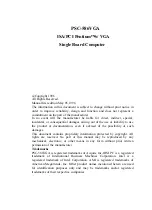
Watchdog Timer (WDT) Programming 3-11
Sy
st
em Inst
allat
io
n
Watchdog Timer (WDT) Programming
System will reset if no retrigger signal has been given after the set time interval
Enable WDT Function
The following table shows how to enable and disable the Watchdog Timer (WDT) circuit using
JP16.
This will prepare the WDT circuit to be ready for the trigger. The WDT is now in standby mode.
Without adding this jumper, the WDT circuit is always turned off.
Initialize, Re-trigger, and Stop WDT
With the WDT enabled, you may configure the “Watchdog Timer Controller” option in BIOS to
determine when the WDT will be initialized.
Enabled = Automatically initialize WDT when booting up.
Disabled = Manually initialize WDT by software at run-time
After you initialize the WDT, the system will reboot if no re-trigger signal is given within a
time-out interval.
There are two methods to program the time-out interval. One is to specify it in the BIOS
(Advanced Chipset Setup) and the other is through software programming over the super I/O
W83627HF chip. The first way is recommended and easier but has fewer choices of time-out
intervals. BIOS provides only eight possible ranges of timeout intervals ranging from 1 second
to 60 minutes. The second method is more difficult and complicated, but provides more choices
of time-out intervals.
A test program is available in
Appendix A, "WDT Programming"
. The program allows
users to specify a refresh interval and the system will simply stay on if the selected refresh
interval is less than the time-out interval specified in BIOS. Otherwise, the system will reboot.
A programming guide is also included in
Appendix A.
JP16
FUNCTION
Short
Enable WDT
NA
Disable WDT




































